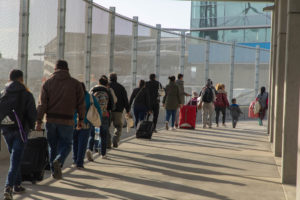Scattered rubble, blistered feet, empty stomachs, and a fear of the unknown. Millions of Ethiopian civilians’ worlds have been turned upside down as a result of a corrupted government. Starting on Nov. 4, 2020, conflict between armed forces in Tigray, a northern regional state in Ethiopia, and the Ethiopian federal army, with aid from its allied forces from Amhara and Eritrea, erupted. Spurred by an alleged attack by the Tigray People’s Liberation Front (TPLF)–created by the Ethiopian Students’ Movement–on the Ethiopian federal government military base, tension between the two opposing groups reached its final straw. Conflicting political ideals between TPLF and the Ethiopian central government engendered two years of civil war and came to an end on November 2, 2022.
Although the war has ended, visible scars have been left in its place and displayed through the humanitarian crisis raging throughout all of the nation. The aftermath of the war gave rise to a displacement crisis, a famine epidemic, a disease outbreak, and a greater abuse of power displayed by the Ethiopian federal government’s militia alongside Amhara and Eritrean troops.
What has been heard, written, and read about the signing of the end of the Tigray War contradicts all primary evidence announcing otherwise. Through the media, myriads of stories of people trapped within the devastation of the war have been brought to light and have been used as a tool to communicate the Tygaryan civilians’ need for external aid and delivery from the conflict. The central government has yet to provide a foundation for the brittle “peace” they claim to have won, as there have been no plans for the reconstruction of the suffering livelihoods of the Tygraryan people.
According to the United Nations, in November 2021, the population of around 7 million Tigray, Amhara, and Afar citizens dramatically decreased as a result of the war, as 2.4 million (and growing) citizens have been displaced and are in dire need of basic everyday necessities, such as food and shelter. The World Food Program has estimated that within these regions, “9 million people need humanitarian food assistance and 83 percent of people in Tigray are food insecure,” illustrating the failed attempt the TPLF made in order to build a better healthcare system and construct a democracy in Ethiopia, where the regional states can actively participate in the political climate.
The idea is that if the government is transformed into an ideal democracy, then the health system would be of greater prioritization amongst the people, therefore, improve in quality, adaptability, and accessibility, especially during times of conflict. As a result of the war, the people of Tigray have been experiencing one of the world’s worst famines seen in a decade, as the war left the country in an economic crisis coupled with the humanitarian crisis where a high percentage of the population is left unemployed and forced to fend for themselves without interference from health systems and the government to allocate medical aid and food. “According to the United Nations, more than 35,000 people are suffering from severe famine conditions in the region, and millions more are at risk of famine” (Raphael, 2021), making this epidemic one that will persist and only come to an end with action from government agencies.
Civilians in Tigray have been surrounded by Eritrean troops, preventing basic resources like food and medical aid from entering the region. Farmers have been unable to continue “harvesting, plowing, or planting, and killing livestock and looting farm equipment.” making supply and income for crop growing decrease and negatively impact the livelihood of farmers and their families.
In an attempt to escape such horrific living conditions, “more than 70,000 refugees have crossed from the Tigray region into neighboring Sudan” where, if discovered by Eritrean soldiers, they could be killed, raped, trafficked, or starved for “dissent.” The Tigray people have been inhumanly treated, and seen as means rather than an end toward the progression of the country.
Due to the ongoing conflict, education, especially amongst the youth and “students with special needs’ (Raphael, 2021), as this has had negative impacts on children with “health and schooling outcomes” for there is no foundational support for its development and growth.
The “consequences of the suspension of public services (e.g. banking, telecommunication, electricity, and transport services)” has made everyday life for the average Tigray civilian a mental, emotional and physical burden. The restrictions on such routine activities have engendered “income losses”, as resources and equipment for work and the means to work have been blocked off by political and armed forces. With no supply and very high demand, the state of the market is dwindling; for this, the people have no way to put their previous professions to work, therefore, are at a standstill.
The forceful interference of the Ethiopian government’s federal militia in the social, economic, and political aspects of the people’s lives after the Tigray war brought mass destruction to the livelihoods of the Ethiopian people, therefore, the nation as a whole.
The aftermath of the war resulted in a famine, increased rape, and the displacement of millions of civilians from their homes and vocations. Although the war has ended, the foundation of peace and reconstruction for the ideal government has long yet to be achieved by the hopeful and resilient Ethiopian people.



